Combe Surname Ancestry ResultsOur indexes 1000-1999 include entries for the spelling 'combe'. In the period you have requested, we have the following 427 records (displaying 391 to 400): Single Surname Subscription | | | Buying all 427 results of this search individually would cost £2,282.00. But you can have free access to all 427 records for a year, to view, to save and print, for £100. Save £2,182.00. More... |
These sample scans are from the original record. You will get scans of the full pages or articles where the surname you searched for has been found. Your web browser may prevent the sample windows from opening; in this case please change your browser settings to allow pop-up windows from this site. Boys entering Wellington College in Berkshire
(1903)
Wellington College, near Wokingham, was originally founded for the education of sons of military officers. A register of boys entering the school from First Term 1859 to Michaelmas 1933 was compiled by F. G. Lawrence for the Old Wellingtonian Society. In each entry the boy's name is given in full, in bold, surname first; age at entry (usually 11 to 14); then, in brackets, the name of the dormitory or house to which he belonged, in italics, with the years of his stay; then his father's name (usually surname and initials, but not christian name) with military decorations where appropriate. School prefects and captains are noted as such; if the boy played cricket for the school, XI with the years; academic honours, scholarships, &c.; a brief biography; and date of death, or (where known) address in 1933. Year of marriage is given, and sometimes the wife's name and/or her father's name. Clearly, those boys who kept contact with the school and/or had distinguished military careers have detailed entries; others disappeared into oblivion on leaving.COMBE. Cost: £6.00.  | Sample scan, click to enlarge
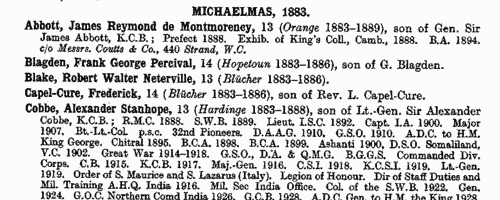
|  Queen's South Africa Medal: Royal Field Artillery: 67th Battery
(1901-1905) Queen's South Africa Medal: Royal Field Artillery: 67th Battery
(1901-1905)
The nominal roll for the Queen Victoria's South Africa Medal - awarded (after her death, in the event) to all who had served honourably in the various campaigns in the Boer War - was compiled from these returns from the individual units. Two sets of form were completed. The main one, as in the sample scan, dates from 1901 and gives regimental number, rank, and full name (surname first), followed by a series of columns relating to different actions - Belmont, Modder River, Paardeberg, Dreifontein, Wepener, Johannesburg, Diamond Hill, Belfast, Wittebergen, Defence of Kimberley, Relief of Kimberley, Defence of Mafeking, Relief of Mafeking, Cape Colony, Orange Free State, Transvaal, Rhodesia, Talana, Elandslaagte, Tugela Heights, Defence of Ladysmith, Relief of Ladysmith, Laing's Nek, and Natal; each entitled the man to a separate clasp to the medal, and a tick or a Yes in the appropriate column indicates the man's actual physical presence in that battle. A final column for remarks is important in those cases where the man was no longer in the unit, by removal, death or desertion. The second form that sometimes occurs was returned in 1905, and covers men entitled to the Second South African War Medal and Clasps. It lists men by number, rank and name, checks whether they had claimed the Queen's South Africa Medal, and then enquires as to their suitability as to three Colony Clasps, which could be awarded for service in the Cape, Orange Free, or Transvaal; whether entitled to Date Clasps (South Africa 1901 and South Africa 1902); whether also entitled to the King's South Africa Medal; any other corps in which served in South Africa; and remarks (such as becoming non-effective, forfeiture, &c.) WO 100/142
COMBE. Cost: £8.00.  | Sample scan, click to enlarge

|  Queen's South Africa Medal: Royal Field Artillery: 68th Battery
(1901-1905) Queen's South Africa Medal: Royal Field Artillery: 68th Battery
(1901-1905)
The nominal roll for the Queen Victoria's South Africa Medal - awarded (after her death, in the event) to all who had served honourably in the various campaigns in the Boer War - was compiled from these returns from the individual units. Two sets of form were completed. The main one, as in the sample scan, dates from 1901 and gives regimental number, rank, and full name (surname first), followed by a series of columns relating to different actions - Belmont, Modder River, Paardeberg, Dreifontein, Wepener, Johannesburg, Diamond Hill, Belfast, Wittebergen, Defence of Kimberley, Relief of Kimberley, Defence of Mafeking, Relief of Mafeking, Cape Colony, Orange Free State, Transvaal, Rhodesia, Talana, Elandslaagte, Tugela Heights, Defence of Ladysmith, Relief of Ladysmith, Laing's Nek, and Natal; each entitled the man to a separate clasp to the medal, and a tick or a Yes in the appropriate column indicates the man's actual physical presence in that battle. A final column for remarks is important in those cases where the man was no longer in the unit, by removal, death or desertion. The second form that sometimes occurs was returned in 1905, and covers men entitled to the Second South African War Medal and Clasps. It lists men by number, rank and name, checks whether they had claimed the Queen's South Africa Medal, and then enquires as to their suitability as to three Colony Clasps, which could be awarded for service in the Cape, Orange Free, or Transvaal; whether entitled to Date Clasps (South Africa 1901 and South Africa 1902); whether also entitled to the King's South Africa Medal; any other corps in which served in South Africa; and remarks (such as becoming non-effective, forfeiture, &c.) WO 100/142
COMBE. Cost: £8.00.  | Sample scan, click to enlarge

| Boys entering Loretto School
(1905)
The Reverend Dr Thomas Langhorne, who came to Musselburgh in Midlothian as an Episcopalian Church clergyman, established a small school for boarders and day scholars at Loretto House, so called because the grounds contained the ruins of the mediaeval chapel of St Mary of Loretto. To celebrate the centenary of the school in 1925, a second edition of the school register was published, edited by A. H. Buchanan-Dunlop. Relatively little was known of many of the earliest scholars, but from 1835 onwards the register generally gives full name, in capitals, surname first; date of birth; period of time at Loretto; a brief biography; date of death; whether brother of any other boy in the register; and a sequential number. COMBE. Cost: £4.00.  | Sample scan, click to enlarge
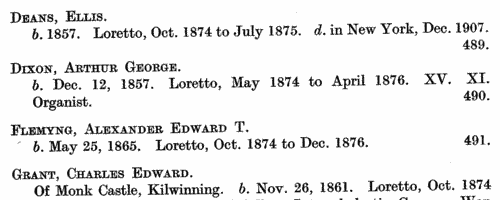
| Boys entering Harrow School
(1907)
This Second Volume of the Second Series of the Harrow School Register was edited by J. H. Stogdon and published in 1925. The boys are listed by term of entrance, and then alphabetically by surname and christian names (in bold). Next, in brackets and in italics, is the school house to which he belonged - or, H. B. indicating a day boy whose family lived in Harrow. Stogdon then gives the father's surname and initials, and address. In cases where the boy was prominent in sports at school, or won academic prizes, scholarships &c., that is given; then the year of leaving the school; a synopsis of his career; and, where known, his address as of 1925, in italics. COMBE. Cost: £4.00.  | Sample scan, click to enlarge
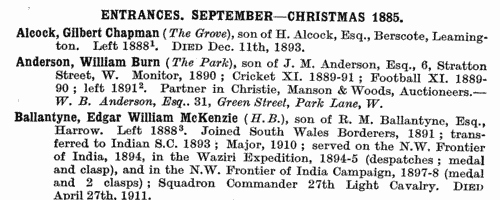
| Boys entering Wellington College in Berkshire
(1908)
Wellington College, near Wokingham, was originally founded for the education of sons of military officers. A register of boys entering the school from First Term 1859 to Michaelmas 1933 was compiled by F. G. Lawrence for the Old Wellingtonian Society. In each entry the boy's name is given in full, in bold, surname first; age at entry (usually 11 to 14); then, in brackets, the name of the dormitory or house to which he belonged, in italics, with the years of his stay; then his father's name (usually surname and initials, but not christian name) with military decorations where appropriate. School prefects and captains are noted as such; if the boy played cricket for the school, XI with the years; academic honours, scholarships, &c.; a brief biography; and date of death, or (where known) address in 1933. Year of marriage is given, and sometimes the wife's name and/or her father's name. Clearly, those boys who kept contact with the school and/or had distinguished military careers have detailed entries; others disappeared into oblivion on leaving.COMBE. Cost: £6.00.  | Sample scan, click to enlarge
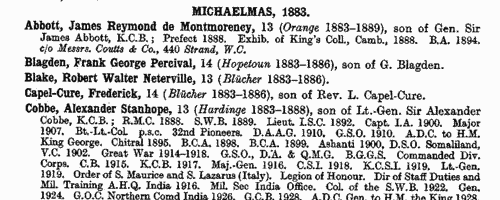
| Boys entering Haileybury College, Hertfordshire
(1909)
Haileybury College, near Hertford, was founded by the East India Company in 1806, and incorporated by Royal Charter in 1864. This register of pupils entering the school from 1862 to 1931 was edited by a master there, Laurence Arthur Speakman. The boys are listed by term of joining the school, and then alphabetically by name (in bold), surname first (in capitals). There is then usually a precise birthdate, and the name and address of his father; his period at the school, starting with abbreviations to indicate the house to which he belonged (B., Batten; B. F., Bartle Frere; C., Colvin; E., Edmonstone; Ha., Hailey; Hi., Highfield; L., Lawrence; Le B., Le Bas; M., Melvill; Th., Thomason; T., Trevelyan), and the first and last forms attended (e. g., IV., fourth form). Where a member of a school team there is then an indication (e. g., XI., cricket). For some pupils, with whom the school had lost touch, Speakman was only able to record the details of their time at Haileybury; but for most a brief career synopsis is then given, and current address (as in 1931) or date of death.
COMBE. Cost: £4.00.  | Sample scan, click to enlarge
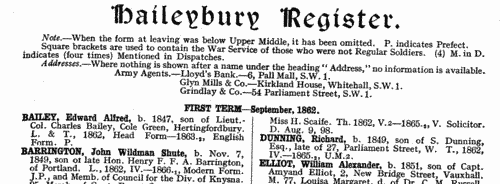
| Boys entering Haileybury College, Hertfordshire
(1915)
Haileybury College, near Hertford, was founded by the East India Company in 1806, and incorporated by Royal Charter in 1864. This register of pupils entering the school from 1862 to 1931 was edited by a master there, Laurence Arthur Speakman. The boys are listed by term of joining the school, and then alphabetically by name (in bold), surname first (in capitals). There is then usually a precise birthdate, and the name and address of his father; his period at the school, starting with abbreviations to indicate the house to which he belonged (B., Batten; B. F., Bartle Frere; C., Colvin; E., Edmonstone; Ha., Hailey; Hi., Highfield; L., Lawrence; Le B., Le Bas; M., Melvill; Th., Thomason; T., Trevelyan), and the first and last forms attended (e. g., IV., fourth form). Where a member of a school team there is then an indication (e. g., XI., cricket). For some pupils, with whom the school had lost touch, Speakman was only able to record the details of their time at Haileybury; but for most a brief career synopsis is then given, and current address (as in 1931) or date of death.
COMBE. Cost: £4.00.  | Sample scan, click to enlarge
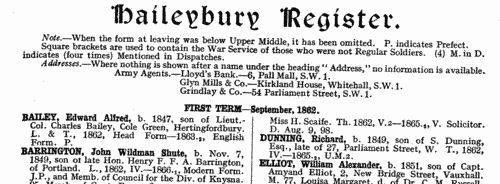
| War Services of British Army Officers
(1915)
Hart's Annual Army List, Special Reserve List and Territorial Force List for 1915 includes this section entitled 'War Services of the Officers of the Active List', covering not only serving officers of the regular army, but also officers of the militia (marked (m)), special reserve (r), territorials (t), volunteers (v) and yeomanry (y). The detailed descriptions of the officers' war services relate not to the Great War, but to previous campaigns, particularly those in South Africa, Egypt, India and China. The regiment &c. in which the officer was currently serving is shown in brackets after his name. COMBE. Cost: £6.00.  | Sample scan, click to enlarge
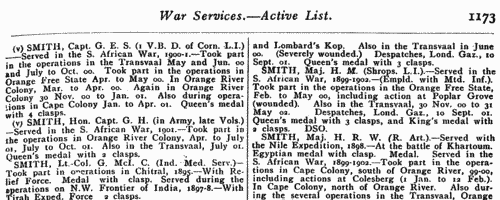
| Owners of Country Houses in Surrey
(1917)
The Horticultural Directory and Year Book was published for 57 years by the proprietors of the Journal of Horticulture, but for 1917 it was acquired by the Gardeners' Chronicle, and a complete revision was undertaken. 'In order to ensure the accuracy of the entries, enquiries were sent to every one of the many thousand persons whose names appeared in the lists. Nor did the work cease there, for in cases where no reply was received, a second enquiry, and in some instances even a third, was sent out. Inasmuch as the War has called many gardeners from their normal avocations, it was not possible to obtain information with respect to all the changes which occurred during the year, and particularly during the closing months. It became necessary, therefore, either to go to press with a certain number of unverified entries or to omit them altogether. After careful consideration, the latter course was adopted, and every unverified entry has been omitted.'
Pages 75 to 187 of the work are occupied by 'A County Directory of the Principal Gardens in Great Britain and Ireland, including Name of Proprietor, Gardener, and Post Town.' This lists country houses possessing substantial gardens tended by a professional gardener.COMBE. Cost: £6.00.  | Sample scan, click to enlarge

|
Research your ancestry, family history, genealogy and one-name study by direct access to original records and archives indexed by surname.
|













